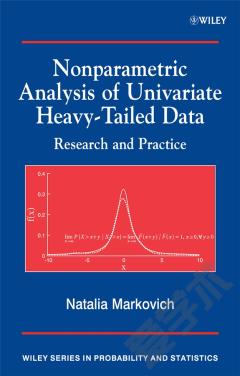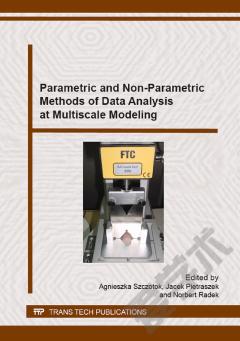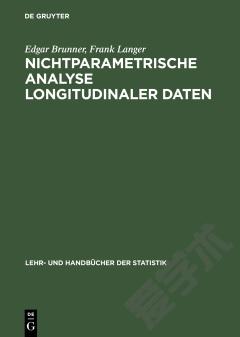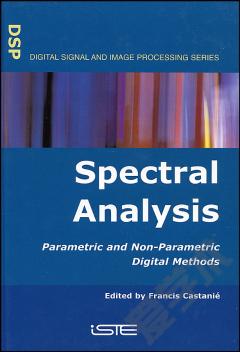Nonparametric Analysis of Univariate Heavy-Tailed Data —— Research and Practice
----- 重尾数据非参数分析
Preface. 1. Definitions and rough detection of tail heaviness. 1.1 Definitions and basic properties of classes of heavy-tailed Distributions. 1.2 Tail index estimation. 1.2.1 Estimators of a positive-valued tail index. 1.2.2 The choice of k in Hill's estimator. 1.2.3 Estimators of a real-valued tail index. 1.2.4 On-line estimation of the tail index. 1.3 Detection of tail heaviness and dependence. 1.3.1 Rough tests of tail heaviness. 1.3.2 Analysis of Web traffic and TCP flow data. 1.3.3 Dependence detection from univariate data. 1.3.4 Dependence detection from bivariate data. 1.3.5 Bivariate analysis of TCP flow data. 1.4 Notes and comments. 1.5 Exercises. 2. Classical methods of probability density estimation. 2.1 Principles of density estimation. 2.2 Methods of density estimation. 2.2.1 Kernel estimators. 2.2.2 Projection estimators. 2.2.3 Spline estimators. 2.2.4 Smoothing methods. 2.2.5 Illustrative examples. 2.3 Kernel estimation from dependent data. 2.3.1 Statement of the problem. 2.3.2 Numerical calculation of the bandwidth. 2.3.3 Data-driven selection of the bandwidth. 2.4 Applications. 2.4.1 Finance: evaluation of market risk. 2.4.2 Telecommunications. 2.4.3 Population analysis. 2.5 Exercises. 3. Heavy-tailed density estimation. 3.1 Problems of the estimation of heavy-tailed densities. 3.2 Combined parametric-nonparametric method. 3.2.1 Nonparametric estimation of the density by structural risk minimization. 3.2.2 Illustrative examples. 3.2.3 Web data analysis by a combined parametric-nonparametric method. 3.3 Barrona s estimator and I 2-optimality. 3.4 Kernel estimators with variable bandwidth. 3.5 Retransformed nonparametric estimators. 3.6 Exercises. 4. Transformations and heavy-tailed density estimation. 4.1 Problems of data transformations. 4.2 Estimates based on a fixed transformation. 4.3 Estimates based on an adaptive transformation. 4.3.1 Estimation algorithm. 4.3.2 Analysis of the algorithm. 4.3.3 Further remarks. 4.4 Estimating the accuracy of retransformed estimates. 4.5 Boundary kernels. 4.6 Accuracy of a nonvariable bandwidth kernel estimator. 4.7 The D method for a nonvariable bandwidth kernel estimator. 4.8 The D method for a variable bandwidth kernel estimator. 4.8.1 Method and results. 4.8.2 Application to Web traffic characteristics. 4.9 The I 2 method for the projection estimator. 4.10 Exercises. 5. Classification and retransformed density estimates. 5.1 Classification and quality of density estimation. 5.2 Convergence of the estimated probability of misclassification. 5.3 Simulation study. 5.4 Application of the classification technique to Web data analysis. 5.4.1 Intelligent browser. 5.4.2 Web data analysis by traffic classification. 5.4.3 Web prefetching. 5.5 Exercises. 6. Estimation of high quantiles. 6.1 Introduction. 6.2 Estimators of high quantiles. 6.3 Distribution of high quantile estimates. 6.4 Simulation study. 6.4.1 Comparison of high quantile estimates in terms of relative bias and mean squared error. 6.4.2 Comparison of high quantile estimates in terms of confidence intervals. 6.5 Application to Web traffic data. 6.6 Exercises. 7. Nonparametric estimation of the hazard rate function. 7.1 Definition of the hazard rate function. 7.2 Statistical regularization method. 7.3 Numerical solution of ill-posed problems. 7.4 Estimation of the hazard rate function of heavy-tailed distributions. 7.5 Hazard rate estimation for compactly supported distributions. 7.5.1 Estimation of the hazard rate from the simplest equations. 7.5.2 Estimation of the hazard rate from a special kernel equation. 7.6 Estimation of the ratio of hazard rates. 7.6.1 Failure time detection. 7.6.2 Hormesis detection. 7.7 Hazard rate estimation in teletraffic theory. 7.7.1 Teletraffic processes at the packet level. 7.7.2 Estimation of the intensity of a nonhomogeneous Poisson process. 7.8 Semi-Markov modeling in teletraffic engineering. 7.8.1 The Gilbert-Elliott model. 7.8.2 Estimation of a retrial process. 7.9 Exercises. 8. Nonparametric estimation of the renewal function. 8.1 Traffic modeling by recurrent marked point processes. 8.2 Introduction to renewal function estimation. 8.3 Histogram-type estimator of the renewal function. 8.4 Convergence of the histogram-type estimator. 8.5 Selection of k by a bootstrap method. 8.6 Selection of k by a plot. 8.7 Simulation study. 8.8 Application to the inter-arrival times of TCP connections. 8.9 Conclusions and discussion. 8.10 Exercises. Appendices. A Proofs of Chapter 2. B Proofs of Chapter 4. C Proofs of Chapter 5. D Proofs of Chapter 6. E Proofs of Chapter 7. F Proofs of Chapter 8. List of Main Symbols and Abbreviations. References. Index.
{{comment.content}}








 京公网安备 11010802027623号
京公网安备 11010802027623号